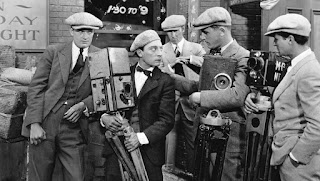EOTO 2 Crime and Women's Sports Reporting
Once America was out of the First World War America was transformed into a society that was known as The Roaring Twenties. The age of prohibition, Women’s suffrage, flappers, and speakeasies oh my. Journalism needed to have extra pizazz just as jazzy as this decade was. News incorporated daily leisurely reads such as local and national crimes which included details about criminals, and murderers, how they committed their crimes, and the answer to the why. Women got their big breakthrough in reporting about athletics after their voices were finally heard.
What is crime reporting and how did it thrive during this era? Crime reporting is a type of journalism where local and national information about crime, criminals, and criminal activity is released to the public. A crime reporter of this era would report firsthand at a crime scene trying to get any information and facts reported to the public immediately. This included descriptive details about criminals, murderers, how they committed their crimes, and why. The police and journalists would work hand in hand. The police provided information to journalists to share with the people while the journalists gathered any information about a crime from the police. Most of the time crime reporters were able to investigate and write stories about unsolved cases. Journalists could provide police with leads by assisting police with their stories to find out “Who did it?”
What was going on when crime was more rampant than in any other decade? Once the United States government enacted the Prohibition Act under Woodrow Wilson alcohol was banned and crime reached its peak. This law had the opposite effect and the crime rate increased rapidly. Prohibition meant that gangs and crime leaders ruled various cities across America. No one was better at committing white-collar crimes than the mob leaders themselves.
What did the 1920s mean for journalism? Investigative journalism thrived during this time, so reporters could write stories frequently and crime reporters were very much needed. During this decade crime was very strategized and criminals were at the top of their game using their illegal moves to scheme their mastermind felonies. On every street corner there was a crime scene that meant a crime reporter would be nearby.
At the scene of a crime, journalists would take notes on a notepad and write down the most important and the most valuable information that a reporter could. News during the 1920s consisted mostly of the technological innovations of modern newspapers and the radio. Breaking News was a term introduced where reporters could gather facts at a crime scene and then relay that message directly to the newsroom. Crime stories would grasp the reader’s and listener’s attention creating an element of fear while informing American Citizens about what was going on in their cities.
Leisure activities and everyday life flourished in newspapers as a popular choice for readers in the 1920s. The women’s suffrage movement meant that women were guaranteed the right to vote. As all the women fought for their voices to be heard journalism and news corporations transformed into a new societal change where women had more prominent roles in writing and reporting. Since so many people read about athletics the need for sports reporters grew. The nineteenth amendment paved the way for women to have the ability to pursue careers in sports reporting. Across The United States in all the major sports-dominated cities there were thirty-five female sports reporters dedicating their time to writing about athletics. Three female sports reporters were credited with being prominent journalists in the 1920s. Margaret Goss was a female reporter for the New York Tribune who reported on all areas of women’s sports. Lorena Hickock was a female reporter who reported on male sports which was rare for a woman to do. Jane Dixon was a female reporter from the New York Telegram who reported on all sports specifically focusing on boxing. Female Sports Reporters provided a brand-new outlook throughout the journalism industry. There were many people against women’s rights in the 1920s however women transformed the sports industry with their stories. As an aspiring female journalist, I always find it remarkable how female journalists throughout this decade were able to succeed in a major male-dominated society by writing about athletics.
As a reader, listener, and watcher of the news, the public can see how transformative The Roaring Twenties was for journalism. Crime Reporters informed American citizens about crimes and how to keep their communities safe. Crime reporters were honest and factual as they brought justice to criminals while respecting and honoring the victims and their families. Organized crime was so strategically planned that it was the birth of the daily reports of crime that we see today. Margaret Goss, Lorena Hickock, and Jane Dixon are three women who changed sports broadcasting forever. The 1920s were an era that defined jazz journalism and modern broadcasts today.







No comments:
Post a Comment